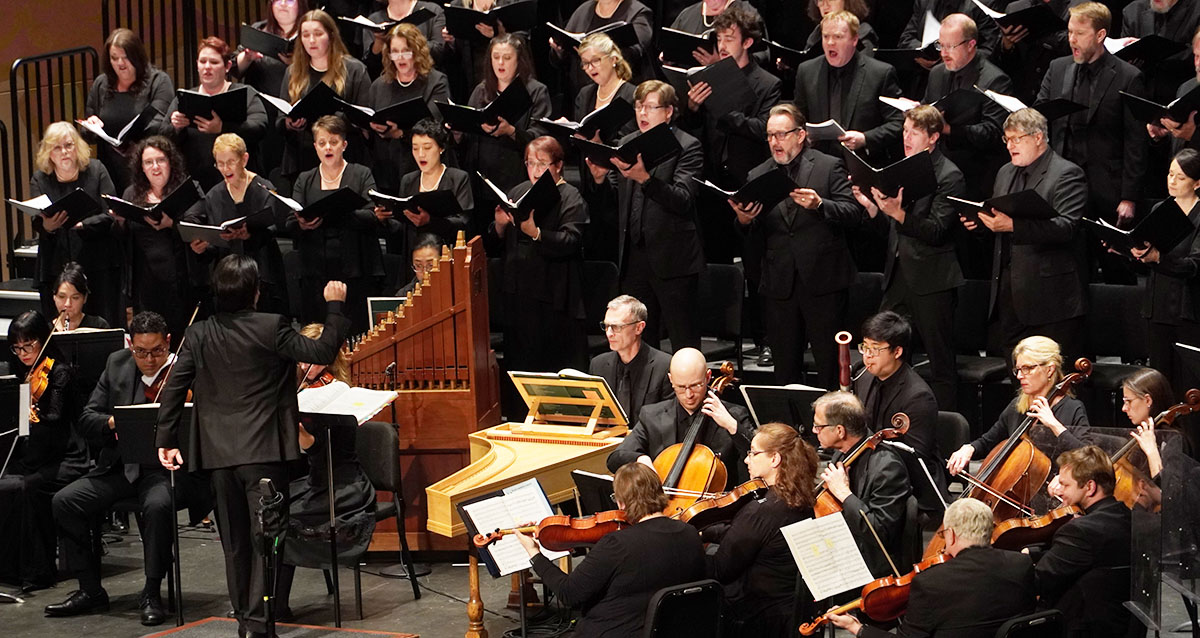Just what does it take for something to become a tradition? A specific concert selling out two years in row is probably a good start.
For the second year, Maestro Aram Demirjian and the Knoxville Symphony Orchestra moved their late-November “Classical Christmas” concert to the Tennessee Theatre on Sunday afternoon, filling the program with Hely-Hutchinson’s A Carol Symphony as the opening act for the “Christmas” section of Handel’s Messiah—and selling out the performance. Of course, Messiah generally gets plenty of amateur, community, and church choir performances this time of year, but a performance by KSO along with the Knoxville Choral Society and top-notch soloists is an opportunity that audiences realize shouldn’t be passed up under any circumstances.
Despite being premiered in 1927 for what would become the BBC radio, A Carol Symphony has not received the public attention in the U.S. that this eminently likable work obviously deserves. The four-movement work is a feast of five carols: “O Come All Ye Faithful,” “God Rest Ye, Merry Gentlemen,” “Coventry Carol,” “The First Nowell,” “Here We Come A-Wassailing.” The tunes are given interesting, even complex orchestral textures and energetically flavored with some charming and driving counterpoint, all performed by the orchestra with what felt like a metaphorically satisfied smile on its face.
Occupying its own little peculiar niche in classical music, George Frideric Handel’s oratorio Messiah has undergone a number of changes in performance standards since its first performance in a Dublin music hall in a post-Easter April of 1742. The work’s U.S. history of Christmas-time performances dates to 1817 when the newly formed Handel and Haydn Society of Boston, a large amateur effort, gave a Christmas day performance of Messiah with a huge chorus and orchestra. As the 19th Century progressed and amateur choral societies became popular, the size of orchestras and choruses for Messiah grew even further to gargantuan proportions. Thankfully, reason eventually won out and organizations began to return to the scale that Handel mostly intended and enjoyed—a plan followed here by Demirjian and KSO.

After intermission, the orchestra re-configured itself into its Baroque chamber orchestra size with harpsichord and “portative” organ in place as the Knoxville Choral Society climbed into its perch behind the orchestra on the Tennessee Theatre stage. This turned out to be a Messiah delivered with a great deal of drama, intensity, and depth thanks to the quartet of excellent soloists: soprano Abigail Santos Villalobos, alto Diana Salesky, tenor Tim Pope, and bass Kevin Burdette. Demirjian and soloists built the intensity of that drama throughout, peaking with the bass aria from Part III, “The Trumpet Shall Sound,” sung with meaningful power by Burdette, and embellished with the anxiously awaited trumpet obligato, played here with a satisfying crispness by Brian Winegardner. Of course, abbreviated Messiahs have to end with the chorus “Hallelujah” with everyone dutifully standing, but still not understanding why.
Kudos, as usual, go to the Knoxville Choral Society as prepared by John Orr. This sizable choral group continues to impress with its clean diction and attractive balance.
This reviewer couldn’t help noticing that a notable percentage of the audience appeared to be visiting the KSO and the Tennessee Theatre for the first time. With this concert Messiah selling out, just as it did last year, there might be every temptation to look upon the concert as a Nutcracker—a seasonal item that reliably attracts a festive and sizable audience that might not otherwise attend. Purists might differ, but maybe that’s not a bad thing in the 21st Century.








